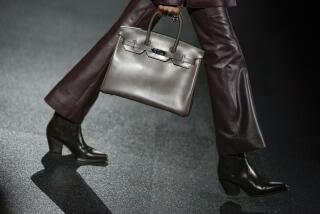Fashion copyrights cut creativity
Prodded by high-end apparel makers, lawmakers from New York and California are trying again to extend copyrights to clothing and accessory designs. It’s a proposal that has come and gone more often in the last century than narrow lapels and aviator sunglasses, never gaining enough support to be enacted. But the Internet is intensifyingfashion piracy, adding urgency to the plea for copyright protection. Websites reveal designs as soon as they’re shown on the runways, enabling low-cost manufacturers to churn out knockoffs almost before the originalsreach the stores.
As much as the imitation galls some designers, though, there are many apparel manufacturers who don’t want copyright law to intrude further on their industry. And they’re right. The likely effect would be less creativity and innovation, which is exactly the opposite of what the framers of the Constitution intended when they empowered Congress to protect intellectual property -- in order to “promote the progress of science and useful arts.”
Copyrights typically cannot be obtained for the design of a “useful” article. There are only two exceptions: a ship’s hull and a design that incorporates images or artwork that can exist independently from the functional aspects of the object. Legislation in the House and Senate would carve out another exception, allowing the designs of clothing, footwear, headgear, eyeglass frames, handbags and other accessories to be protected under copyright for three years. That’s a significantly shorter period than the protection for music, movies and books, but the maximum penalty for infringing would be higher: $250,000 instead of $150,000.
There are at least three fundamental flaws with the proposal. First, it would enable designers to claim copyrights over styles and features they didn’t invent. There are only so many ways to design a T-shirt or a strapless dress, and chances are good that they’ve all been done already. Second, lawsuits would more likely target U.S. apparel makers than manufacturers in distant or undeveloped low-wage countries. Meanwhile, judges would become the arbiters of fashion innovations, deciding whether garments were sufficiently unique or excessively similar.
Finally, applying copyrights to apparel design would discourage the copying that actually promotes the sale of designer clothing. Sales of high fashion aren’t driven by the public’s need to be clothed but by the status an exclusive garment or handbag conveys. The more common a look becomes, the more the fashion-conscious seek out the next thing. It’s a cycle: Innovations become trends, which beget more innovation. And without copying, there’d be no trends.
More to Read
A cure for the common opinion
Get thought-provoking perspectives with our weekly newsletter.
You may occasionally receive promotional content from the Los Angeles Times.






